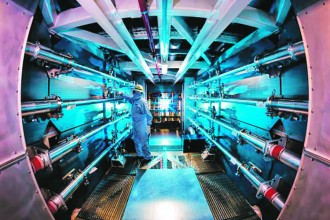The Young Scientist
The Young Scientist
April 3, 2023By AILEEN O’CATHERINE

It has been called one of the most impressive scientific feats of the 21st century, equal to the Wright brothers’ first flight at Kitty Hawk. At 1:03 a.m. Dec. 5, 2022, scientists at the Lawrence Livermore National Laboratory’s National Ignition Facility in Livermore, Calif., performed an inertial confinement fusion experiment that produced more energy from a fusion reaction than the energy they put in to create the reaction. This condition is known as ignition, or scientific energy breakeven. The experiment took place in a facility where 192 laser beams delivered 2 million joules (a joule is a unit of energy) of ultraviolet energy to a peppercorn-size fuel pellet to create fusion. If scientists can successfully replicate ignition in the lab, they may be on their way to creating a form of energy, nuclear fusion, that could provide the world with an ongoing, clean source of renewable energy.
The ignition event mimics the power of the sun. Inside the sun, atoms of hydrogen fuse with atoms of helium to create huge amounts of heat and energy. Massive amounts of gravity make the fusion happen. The heat generated in the sun is tremendously hot (27 million degrees F), and the solar energy the sun emits streams across 93 million miles of space to reach us, making life on earth possible.
Scientists have long theorized nuclear fusion is possible. If hydrogen, a gas that can be safely made from water, is placed in one end of the facility, and its atoms get smashed with enough intensity to create helium, which is a clean and safe gas, then large amounts of heat energy could be created. The energy could then be used, for example, to power generators to produce electricity. The experiment proved the theory was entirely possible, and now scientists will seek to replicate their success.
Nuclear power already exists. But today’s nuclear power plants use a process called nuclear fission, which splits up large atoms to release energy. Although today’s nuclear power plants create energy, they also create hazardous radioactive waste. The waste is a problem to maintain and an even bigger problem to get rid of and store without making people sick.
Nuclear fusion is a much cleaner and safer form of energy than oil, gas or nuclear power. It could solve our energy needs. Nuclear fusion has the potential to do so much good, especially in the face of climate change and the need to move away from fossil fuels. About 80 percent of the world’s energy is currently produced via fossil fuels. Renewable energy, energy that comes from the sun, wind or oceans, is what we need to keep the world powered without creating pollution. Since the world’s population continues to grow, it is important to create more clean energy to sustain them without harming the planet. Fossil fuels create carbon that warms the atmosphere. Global warming is real, but with luck and the good work done by today’s scientists, there may be a brighter future for us all that doesn’t involve radioactive waste, carbon dioxide pollution or greenhouse gas emissions.
Scientists see nuclear fusion as the future. At Sandia National Laboratories in Albuquerque, a team of researchers is testing materials to make magnetic confinement fusion reactors (tokamaks). These reactors use magnetic fields to shape plasma that generates power from nuclear fusion. The early stages of nuclear fusion provide today’s young scientists with a future rich with the possibilities of applied science.




